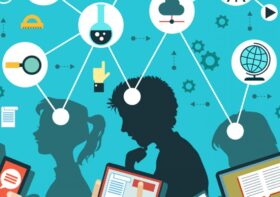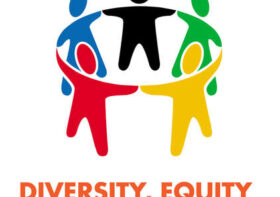Digital Ethics Audit

To translate the digital learning mission statement, which has three (3) guiding principles (empowering, holistic transformation, and wisdom in using technology), I conducted a Digital Ethics Audit to the Head of the English Department in a private university in Jakarta through interview. There are seventeen (17) questions in the discussion addressing the Digital Citizen Advocate standard (ISTE Standard 7 for Coaches) and course objectives of four modules in Values, Ethics, and Foundations in Digital Education (EDTC6101). The standards and objectives can be seen clearly in the following parts.
ISTE Standard for Coaches
ISTE Standard 7: Digital Citizen Advocate
Coaches model digital citizenship and support educators and students in recognizing the responsibilities and opportunities inherent in living in a digital world. Coaches:
- Inspire and encourage educators and students to use technology for civic engagement and address challenges to improve their communities.
- Partner with educators, leaders, students, and families to foster a culture of respectful online interactions and a healthy balance in their use of technology.
- Support educators and students to critically examine the sources of online media and identify underlying assumptions.
- Empower educators, leaders, and students to make informed decisions to protect their personal data and curate the digital profile they intend to reflect.
Course Objectives:
- Identify, articulate, and respond to major ethical issues related to the digital realm, including fair use, plagiarism, piracy, security, and citizenship.
- Articulate, model, and facilitate safe, healthy, and legal uses of digital information and technologies, including developing and curating a digital identity.
- From a theological perspective, articulate, model, and promote strategies for addressing moral issues and character formation in digital information and technology.
- Model and promote diversity, cultural understanding, and global awareness by using digital-age communication and collaboration tools to interact locally and globally with students, peers, parents, and the larger community.
- Model and promote strategies of social justice in order to help students and teachers achieve equitable access to digital tools, resources, and technology-related promising practices.
Digital Ethics Audit Results and Findings
The results and findings cover four aspects, including Philosophical and Theological Foundations, Digital Wisdom, Digital Diversity, Equity and Inclusion, and Digital Wellbeing.
Philosophical and Theological Foundations
In this module, the audit addresses point 7b of ISTE standard and course objective 3. There are four (4) questions regarding:
1. What strategies does the department have to foster a culture of respectful online interactions and a healthy balance in using technology among faculty members and students?
2. What moral issues and character formation does the department promote among faculty members and students using digital information and technology?
3. How does the department promote those moral issues and characters?
4. What challenges does the department have?
Regarding the Philosophical and Theological Foundations, the audit results reveal that the department made netiquette guidelines for students to foster a culture of respectful online interactions and a healthy balance in using technology among faculty members and students. The department also agreed that it was also essential to make one for the faculty members. So, both students and faculty collaborate to create a conducive atmosphere in the classroom. A classroom wherein the teacher encourages positive student behavior provides beneficial learning inside and outside the classroom (Denti, 2012). Explicitly, this practice is an example of empowering students through implementing good values.
The department considered academic honesty a crucial moral value promoted among faculty members and students when using digital information and technology. Notably, most assignments required students to collect information from the web, including or citing references. In the digital era, faculty members and students partner to use technology, find information, and create products that demonstrate their understanding. To this extent, faculty members guide students by asking the right questions, putting things into the proper context, and ensuring quality and rigor. This way, the new teaching roles that the 21st-century offers are so much better, more powerful, and so much more interesting than what came before that most teachers will, once they get their heads around those roles, rush to embrace them (Prensky, 2012).
However, it was challenging as some students are just ignorant; they say they forgot. To this extent, both department and faculty must keep reminding students in each classroom contract and explicitly stated in each assignment. As we know, the increase in online-based learning facilitates educational advances and poses challenges to academic integrity. Academic Integrity is essential to develop long-term and meaningful relationships with a professional group or community, such as school or university. The integrity of online teaching and learning would be enhanced by articulating and enforcing codes of ethical conduct. However, all stakeholders, students, faculty, and administrators should be active participants in writing and implementing these codes (Coleman, 2011). Therefore, this value is constantly introduced in the department codes and conducts at the beginning of the semester. Moreover, a penalty is applied if academic dishonesty occurs. Further elaboration has been discussed in Promoting Academic Integrity in Online Learning.
Digital Wisdom
In this module, the audit addresses point 7c and 7d of ISTE standard and course objectives 1 and 2. There are four (4) questions regarding:
1. What major ethical issues related to the digital realm, including fair use, plagiarism, piracy, security, and citizenship identified among faculty members and students?
2. What would the department do to articulate, model, and facilitate safe, healthy, and legal uses of digital information and technologies, including developing and curating digital identity?
3. What strategies do the department have to support educators and students to examine online media sources and identify underlying assumptions critically?
4. What strategies do the department have to empower educators, leaders, and students to make informed decisions to protect their personal data and curate the digital profile they intend to reflect?
Regarding digital wisdom practice, the audit results reveal that the most common ethical issue is plagiarism. Remarkably, this ethical issue was found in the writing assignment. The department made an academic writing guide to avoid plagiarism in students’ writing to address this issue. The guide provides examples of how to cite appropriately, subscribing to Turnitin so the lecturers can help check the similarities found in students’ work (essay). McGee (2013) proposed strategies to prevent academic dishonesty related to the offense (plagiarism, false identity, cheating), institutional policies, and technology configurations. They are:
- Make Academic Integrity Expectations Clear
- Construct Valid Assessments and Delivery with Foresight
- Make the Most of the Technology
- Utilize Pedagogical Strategies
The department has to support educators and students in examining online media sources and critically identifying by providing a “Creative and Critical Inquiry” class. Some faculties provided dummies questions to help students be critical to online sources or pointers to help them.
So far, through the faculty members, the department encourages the students to be careful in curating their digital profile (esp in social media), in posting the pictures they intend to share with others (especially for the public). Mainly, during a time of tremendous and rapid change in the information landscape, a critical consideration will be how best to integrate and inculcate digital literacies in the curriculum so that learners can develop a deep and well-informed understanding of what it means to be a consumer, creator, and sharer of digital content (Jacobson et al., 2019).
Digital Diversity, Equity, and Inclusion
In this module, the audit addresses point 7a of ISTE standard and course objectives 4 and 5. There are four (4) questions regarding:
1. How would using digital-age communication and collaboration tools interact locally and globally with students, peers, parents, and the larger community?
2. How would the department promote strategies of social justice in order to help students and teachers achieve equitable access to digital tools, resources, and technology-related promising practices?
3. What strategies do the department have to inspire and encourage educators and students to use technology for civic engagement and address challenges to improve their communities?
4. What are some of the challenges you have encountered in promoting equitable access to digital tools?
Regarding the practice of digital diversity, equity, and inclusion, the audit finding shows that the department has promoted diversity, cultural understanding, and global awareness by using digital-age communication and collaboration tools to interact locally and globally with students, peers, parents, and the larger community. For example, specifically for students, the lecturers were trained to use several digital platforms for teaching. Some students were also invited (teaching assistants) to participate. Another activity was conducted in a classroom by reading novels from different countries that promote empathy expression. In this activity, the department is collaborating with an American university. Besides, the department encourages students to participate in student exchange programs to experience the cultural and global environment.
To help students and teachers achieve equitable access to digital tools, resources, and technology-related promising practices, the department uses the digital platform that requires minimum specifications so that all students in the class can experience and practice pretty.
Moreover, the department encouraged faculty members to share their teaching expertise and use technology for educators in Indonesia during the pandemic. To this extent, the department was collaborating with the university, organizing a webinar called Power Up Program. In this program, the faculty members and students were moderating their session, which allows them to be more accessible in using technology for community use. The sessions also allow the teachers from the outer community, learn and feel encouraged and implement the technology used in their classroom.
The department found challenges in promoting equitable access to digital tools due to the different internet access quality, device specifications, cultures, and values. Mainly, the teaching and learning activities were conducted online during the pandemic. Some students found internet connection during the online learning as they had limited quota or internet data. Fortunately, the Indonesian government provided data subsidies for all students, teachers, and lecturers around Indonesia to minimize the internet-connected problem. This program is included in the social protection program targeted at assisting economically vulnerable communities in Indonesia. The Central Government cooperates with the Regional Government to provide this assistance as a strategy for economic recovery and improving people’s welfare during the pandemic (The Business Time, 2021).
Digital Wellbeing
In this module, the audit addresses point 7b of ISTE standard and course objective 3. There are five (5) questions regarding:
1. What ways is the department educating and advocating respect online and responsible technology usage among students?
2. How successful have these efforts been so far, and what do you feel has contributed to this success?
3. How is the department enforcing these strategies and dealing with the consequences of non-compliance?
4. How can the department involve families in fostering a culture of respectful online interaction?
5. What are some of the challenges you have encountered in trying to partner with educators, leaders, students, and families to foster a culture of respectful online interactions and a healthy balance in their use of technology?
The audit reveals that the department keeps educating and advocating respect for online and responsible technology usage among students regarding digital well-being practice. For example, the department provides a netiquette guide for students, especially for classroom participation.
So far, the effort it is successful. Students can respect the lecturers and classmates. However, due to the exceptionally long time for the students to learn from home, it might be challenging to stay proper.
The department has enforced various strategies to educate and advocate respect online and responsible technology usage among students by providing socialization prior to/during the pandemic, reminding them once it is too much to handle. However, so far, there are no directive consequences yet for non-compliance.
However, the department has not yet involved families in fostering a culture of respectful online interaction. This way, the department finds some possibilities to organize a parent’s meeting to provide online interaction literacy in the future. It is believed that some challenges appear due to different values, refusal due to different perspectives – although this rarely happens.
References
Coleman, Phillip D. (2012). Ethics, Online Learning and Stakeholder Responsibility for a Code of Conduct in Higher Education, Kentucky Journal of Excellence in College Teaching and Learning, 9(3). Available at: https://encompass.eku.edu/kjectl/vol9/iss1/3
Denti, L. G. (2012). Empowering Students Through Proactive Teaching. In Proactive Classroom Management, K–8. A Practical Guide to Empower Students and Teachers. Monterey Bay, CA: California State University. https://uk.sagepub.com/sites/default/files/upm-binaries/46479_denti_ch_1.pdf
International Society for Technology in Education (ISTE; 2021). Standards for Coaches.
Jacobson, T., Gilchrist, D., Head, A., & Lippincott, J. (July 29, 2019). 7 Things You Should Know About Digital Literacies, EDUCAUSE Learning Initiative. https://library.educause.edu/resources/2019/7/7-things-you-should-know-about-digital-literacies
McGee, P. (2013). Supporting Academic Honesty in Online Courses, Journal of Educators Online 10(1). https://www.researchgate.net/publication/277197722_Supporting_Academic_Honesty_in_Online_Courses
Prensky, M. (2012). From Digital Natives to Digital Wisdom. In From Digital Natives to Digital Wisdom: Hopeful essays for 21st Century learning (pp. 201–215). essay, Corwin. https://marcprensky.com/writing/PrenskyIntro_to_From_DN_to_DW.pdf
The Business Time. (August 17, 2021). Indonesian government’s strategies in response to the Covid-19 pandemic. https://www.businesstimes.com.sg/hub/indonesia-76th-independence-day/indonesian-governments-strategies-in-response-to-covid-19



Leave a Reply